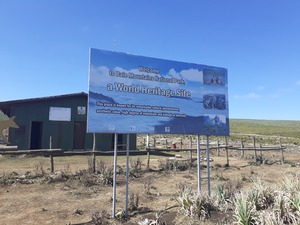Bale Mountains National Park

Bale Mountains National Park covers a variety of landscapes, most notably Africa’s largest area of afro-alpine habitat above 3,000m with glacial lakes and volcanic peaks.
The park has several distinct and unique habitats, such as the Northern Grasslands (Gaysay Valley), Northern Woodlands (Park Headquarters), Afro-alpine Meadows (Sanetti Plateau), Erica Moorlands, and the Harenna Forest (a moist tropical rainforest). It holds endemic mammals such as Mountain Nyala and Bale Monkey, and has the most important remaining population of Ethiopian Wolf. The area serves also as a genetic reservoir for Wild Forest Coffee.
Community Perspective: Wojciech enjoyed the diversity of the landscapes on offer and recommends spending a day or two.

Map of Bale Mountains National Park
Community Reviews
Wojciech Fedoruk

Site visited in January 2024.
It took almost 45 years to finally inscribe this place on the list and I am wondering why. After my visit I think the site definitely has OUV. Anyway, the park administration is so happy with the inscription that already 4 months later there are new billboards advertising Bale as a world heritage site. There is no commemorative plaque or UNESCO logo, or at least I couldn’t find it.
The park is in many respects unique and important for three countries - rivers starting here supply water to Ethiopia, Kenya and Somalia. And they have something to power them with, because the rainy season here lasts 9 months.
The park is known for its biodiversity - from mixed forests through forests with the spectacularly blooming Hagenia abyssynica species to heathlands and a completely barren landscape in the highest parts. And in the southern part - Harren's Forest - truly tropical vegetation reigns. The fauna is no less rich, only a small part of which we were able to see, and even less of which we were able to photograph.
The symbol of the park is the mountain nyala, a huge antelope that lives in the northern part of the park. It can be seen entering the park through its headquarters in Jinsho, just off the main road from Shashamane to Bale Robe. We visited the reserve in the late afternoon and I do not recommend this solution - we saw a lot of antelopes, but in poor light it was impossible to take good photos.
The next day we visited the central part of the park. We crossed the border of the park half an hour after leaving the hotel in Goba and almost immediately the landscape changed - we left the forests and entered meadows covered with heath and moss. No wonder, after all we were already at an altitude of 3,000 meters. The further, the higher - we finished at an altitude of 4,377 m above sea level, on the top of Tulu Dimtu. The road that leads here is the highest road in Africa!
At the top, the landscape was even more severe, and the half-hour trek that we did nearby gave almost everyone a headache - the altitude is very noticeable, and we had no acclimatization along the way.
Fortunately, an hour later we descended about a kilometer lower, to the Harenna Forest. We did two hikes there - the first one in a fantastic forest that could serve as a setting for a fairy tale (see photo #2). The second, longer one, in a typical jungle, covered mainly with bamboo. We reached the waterfalls called Bamboo by the guide, although this is probably not the official name since it is not confirmed by the national park website. Apart from the waterfalls, we managed to see a species of monkey that is endemic to this place - Bale Mountains vervet (Chlorocebus djamdjamensis), also called jam jam (photo #3). These monkeys are very shy, so taking a good photo is not easy.
We were more lucky on the way back, where the guide made it a point of honor to track down the Ethiopian wolf, also called kaberu or Ethiopian jackal, a species endemic to Ethiopia. And it worked, we saw wolves about three times, and last time they almost ran across our road (photo #4). The species feeds primarily on rats, of which we saw plenty. Unfortunately, they are so active and shy that none of them managed to take a photo.
To sum up, we had a great experience and I think Bale Mountains is a well-deserved entry on the WH list. It is worth spending a day or two here, seeing the biodiversity of this place live.
Community Rating
Site Info
Site History
2023 Inscribed
2022 Postponed
Due to >1 nomination proposed by State Part in same year
2018 Upstream Process
1981 Deferred
At Bureau - Not yet legally defined/protected
1980 Deferred
1979 Deferred
Bureau - more thorough evaluation required
Site Links
Unesco Website
Related
In the News
Connections
The site has 14 connections
Ecology
Human Activity
Visiting conditions
WHS on Other Lists
World Heritage Process
Visitors
15 Community Members have visited.
